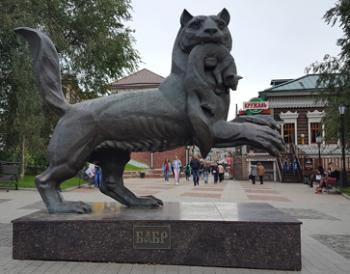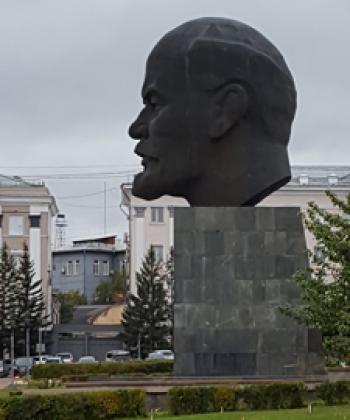Tips on riding the Trans-Siberian Railway
This item appears on page 26 of the November 2019 issue.
Traveling independently across Siberia on the Trans-Siberian Railway was one of my more challenging trips. (I don’t speak Russian.) The following tips concern the train ride, itself.
I rode four different trains from Vladivostok to Moscow, Sept. 7-22, 2018. The trains’ routes, numbers, etc., were Vladivostok to Ulan-Ude (7 N, 1st class [65.5 hours]), Ulan-Ude to Irkutsk (69 Y, 2nd class [8.3 hours]), Irkutsk to Yekaterinburg (81 I, 2nd class [53.5 hours]) and Yekaterinburg to Moscow (15 E, 2nd class [25.2 hours]).
My dilemma was deciding whether I wanted a cabin all to myself, which could be boring, or to share with one or more strangers, which could be either great or awful. On the longer legs, I bought multiple tickets, paying for all the berths in one cabin so I would have the cabin to myself. On the shorter legs, I bought only one berth.
I ended up always having a compartment to myself, even on the shorter legs, so I think September may be a shoulder season.
For the first leg of the trip, I paid $596.91 ($298.45 for each of two tickets). For the second leg, my one ticket cost $42.19. For the third leg, I bought four tickets ($155.54 apiece) for a total of $622.16, and for the final leg I bought a ticket for $228.35.
As for meals, I was provided one complimentary lunch or dinner on each of the three overnight trips. It was only one lunch or dinner per leg, not per day.
I didn’t know that any meals would be included. When the meal was brought to my cabin, that was when I found out about it, and I didn’t know what to expect on subsequent days. I’m guessing the complimentary food was included in the first- or second-class ticket.
For my other meals in the dining room, most of which were full meals, I charged a total of about $150 on my Mastercard.
PURCHASING TICKETS — If you do not speak Russian, it’s much easier to purchase tickets online in advance. I didn’t compare different websites, so I can’t say which is best, but the site I used was that of Trans Siberian Express (www.transsiberianexpress.net).
For any given day, there were several choices of trains. The site indicated the departure time, arrival time, duration and cost of each ride to the intended destination. The site also showed a rating for each train.
The train tables all were on Moscow time, but this site also had the option of displaying local times for departure and arrival locations. There was another link that showed all intermediate stops, and that list only showed Moscow times. (Note that travel between Vladivostok and Moscow covers eight time zones.)
Important — for every city you plan to visit, it is crucial to know the local time as well as the time in Moscow. Suppose you want to leave Vladivostok at 6 a.m. on Sept. 7, traveling west. Instead of entering the 7th as your departure date, you should enter Sept. 6 at 11 p.m., since Moscow is seven hours earlier than Vladivostok.
To ascertain these time differences, I first referenced the Lonely Planet guidebook “Trans-Siberian Railway” (5th edition). For each city covered in the book, the section purported to show the time offset from Moscow. Unfortunately, some of these offsets were wrong.
I didn’t check every city, only the four I’d be visiting: Vladivostok, Ulan-Ude, Irkutsk and Yekaterinburg. All four were wrong. The guide (incorrectly) showed the four offsets, respectively, as Moscow +10, +8, +8 and +5. The correct offsets are +7, +5, +5 and +2. I suspect the guide was mistakenly showing offsets from Coordinated Universal Time (UTC).
My copy of another Lonely Planet guidebook, “Russia” (7th edition), showed the correct offsets. I suggest getting the offsets from at least two independent sources.
HOW TO KNOW WHEN YOU REACH YOUR STOP — Missing my stop was my greatest concern. I rode four different trains, none of which had announcements for the stops, and there were no electronic displays showing either the current or the next stop.
Don’t count on being able to see a sign at the station. Some stations have multiple signs, but many have only one, and it might not be visible from your car. At many stops, your train may not be on the track closest to the station, and your view of any sign might be blocked by another train.
Don’t think you can merely count the stops. This might work on a short trip, but my first ride, from Vladivostok to Ulan-Ude, had over 30 stops and took over 65 hours! Some stops may be in the middle of the night.
You could try asking a train attendant, but the attendant isn’t likely to speak English. If you wait until the train stops, it might be too late. Once the train stops, attendants get off the train to check the tickets of incoming passengers, and some stops last only a minute or two.
My solution was to go on the website and print a list of all the stops. The schedule showed the arrival time at each, using Moscow time. I then wrote in the arrival time for each stop according to the time zone of my next destination.
After boarding the train, I set my watch to the time zone of my destination. At each intermediate stop where I could verify the location, I compared my watch time to the anticipated arrival time I had penciled in. My system only worked if the train was running on time. Luckily, every time I checked, the train was within five minutes of its planned schedule.
Do not try to use local time. While riding the train, you’re not likely to know when you change time zones! None of my trains had Wi-Fi.
I also made a quick-reference chart showing the time differences between my hometown of Chicago and every city I’d be visiting.
USEFUL THINGS TO TAKE — The bathroom amenities were not consistent from train to train or from car to car. In some cars, there was running water and soap. In one car, there was running water and no soap. Another had soap but no running water. Packing some soap might be useful.
Note: In the train bathrooms I encountered, you weren’t supposed to put toilet paper (or anything other than human waste) in the toilets. Toilet paper was to be thrown into waste receptacles.
Be aware that the running water in the bathroom is not drinkable. Every car had a container of boiling water intended for making tea or instant coffee. I found it was helpful to have several empty bottles, preferably not plastic. When there was no water in the bathroom, I would fill bottles with boiling water, let them cool and use them in the bathroom or just for drinking.
It did not occur to me to buy food for the train until I was in a supermarket in Yekaterinburg; I bought one bowl of noodles. To save money, when you’re in a town, go to a supermarket and buy packages of tea, bottles of instant coffee, bowls of noodles and anything else you might wish to consume. This is much cheaper than buying tea or coffee from the dining car.
If anyone has questions, I can be contacted at kenlevine2003@yahoo.com.
KEN LEVINE
Des Plaines, IL




